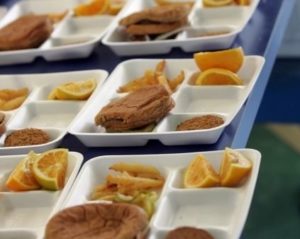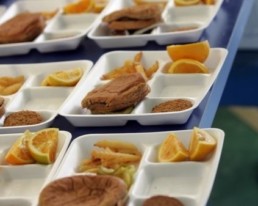Indoctrinating the Youth: National Pork Board Spins Yarns About Modern Meat Production
By Dan Imhoff
A few months ago, while reading an article about an independent pig farmer, I stumbled upon a curious case of “social engineering.” The farmer was lamenting how hard it was to place a story about his responsibly raised pork. He cited the National Pork Board—with its $60 million annual budget and arsenal of media resources to promote “the Other White Meat”—as a chief obstacle for small farmers.
A website link in the the article led me to a coloring book called “Producers, Pigs & Pork.” Innocuous at first glance, it is a book (or downloadable PDF) of simple drawings inviting kids to color in between the lines and “learn more about pigs.” Published as part of the “Pork4Kids” program, the storytelling takes place on a fourth grade level. And given the realities of contemporary livestock production, it’s quite a tale.
We travel with narrator Billy to a 100 year-old farm where we meet smiley farmer Jones and fresh faced veterinarian Dr. Sarah. Huge feeding silos and windowless barns are outlined for kids to color in. “This is fun!” Billy exclaims. “I’ve never been to a pig farm before.”
Young minds are told that fast growing pigs need lots of corn and soybeans (not table scraps) to grow to a market weight of 270 pounds, that veterinarians are there to look after them if they fall ill, and that pigs no longer grow up in the mud so they can stay healthy and happy.
The veterinarian’s prominence in the story is especially curious. Maps and surveys done by the American Veterinary Medicine Association paint a completely different picture of veterinarians on large livestock operations. In fact they detail a lack of veterinarians in many states where livestock production has consolidated: Iowa, Illinois, Minnesota and North Carolina. What’s more a battle is raging right now over the abuse of antibiotics, fed routinely in feed and water rations to animals, without veterinary consult.
Of course, in the real world of Concentrated Animal Feeding Operations, the stench from 2,500 pigs jammed into a single hog barn would send Billy running for the exit clutching his barf bag. Billy might have nightmares after witnessing the crazed repetitive behaviors like bar chewing and pacing that intensive confinement induces in animals who naturally want to spend the day wallowing in mud, searching for food, and socializing in appropriate numbers.
According to the National Pork Board, “pigs can’t use all the feed they eat, so they produce manure. … this makes our crops grow better.” There is no mention that the immense output of untreated animal waste contained in a holding pond on the Jones’ modern factory farm could be equivalent to a small city. Or that the manure contain hundreds of compounds including antibiotics, hormones, heavy metals, and toxic gases.
As the story line of “Producer, Pigs & Pork” unfolds, so does its inherent magical realism. All is well down on the “farm”, even though the animals’ lives are any where close to natural. Visitors wear boots and coveralls to avoid passing germs to animals. In one final move of creative story telling, pigs turn into roast, pork chops, ribs and other cuts without transport to or slaughter at a processing facility.
This and a number of other coloring books are funded by the Pork Checkoff Program, a product of the 1985 Farm Bill and administered by the U.S. Department of Agriculture. U.S. pork producers and importers pay $0.40 per $100 of value when pigs are sold and when pigs or pork products are brought into the United States. The $70 million dollar annual budget for communications, research, and marketing is significant.
Feed Your Children Well
 The Child Nutrition Act is up for reauthorization by September 30. This is a federal government policy that sets the rules and standards and uses tax dollars to—among other things—provide a daily reimbursement for school lunches. Right now this amounts to $2.57 for a free lunch, including labor and ingredients. It is nowhere close to what most school districts need to put healthy foods on our cafeteria tables and reward all the people who make that possible. Congress will soon consider adding one dollar per meal to the reimbursement, and this still might not be enough.
The Child Nutrition Act is up for reauthorization by September 30. This is a federal government policy that sets the rules and standards and uses tax dollars to—among other things—provide a daily reimbursement for school lunches. Right now this amounts to $2.57 for a free lunch, including labor and ingredients. It is nowhere close to what most school districts need to put healthy foods on our cafeteria tables and reward all the people who make that possible. Congress will soon consider adding one dollar per meal to the reimbursement, and this still might not be enough.
Often when we think of huge “omnibus” government legislations like the Transportation Bill, the Energy Bill, or the Farm Bill—huge public spending programs with real life consequences—they seem so complex and tedious it is hard to understand how they affect us personally. It’s easy to get lost in the billions and trillions, in the alphabet soup and acronyms, in highway projects and corn monocultures in the Midwest. One of the beauties of the National School Lunch Program is that we can see the impacts on a personal level. We can look around in our communities and see our kids who depend on these programs. The Child Nutrition Act touches home in every community around the country.
This year the US arm of the international movement known as Slow Food is circulating a petition asking for some very reasonable changes to the Child Nutrition Act:
• $1 increase in the reimbursement per meal;
• grants for Farm-to-School and school garden projects to educate every single child in the country on where food comes from, and get the culture back in agriculture;
• financial incentives for schools to purchase as many fruits and vegetables as possible from local farmers to keep that money in the community, and to shorten the distance our food has to travel before it reaches our children’s cafeteria tables.
All this makes sense and deserves our support if only for one single reason. Children need proper nutrition to be good students. They can’t make it through an afternoon of focused attention without healthy food. This is actually a national security concern. We can’t afford to be a nation of under-achievers, at least not if we can help it.
Fortunately, there is a great shift in consciousness occurring around food and public health right now. Locally grown healthy food is being seen as a catalyst and dynamic organizing principle to revitalize local economies, to compensate for a future with less oil, to deal with a planet that is heating up, to address an obesity crisis that is verging on disaster.
The concept of feeding all of our children well, of teaching them about the beauty and complexity of food production through school gardens and local Farm-to-School programs which actually feed them, should be a community as well as a national priority. But in order for these things to happen, Congress needs to authorize more funding for the program. We should see this long overdue increase to the Child Nutrition Act as a down payment on a new generation that will have a lifetime of good eating habits engrained in them. The idea of healthy foods as preventive health care—perhaps even as medicine—is a concept that can and should change the world.
Find Slow Food's petition here.
Find info on HR 1324, a bill introduced by Lynn Woolsey relating to Child Nutrition Act.
Dan Imhoff is the director of Watershed Media, publisher of the newly released book, "Smart By Nature," a collaborative project with theCenter for Ecoliteracy.

